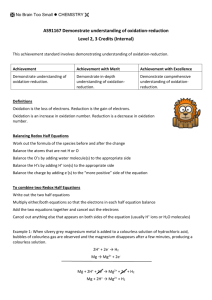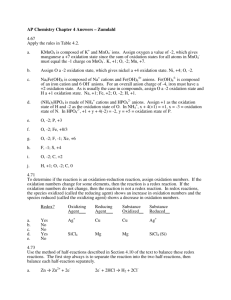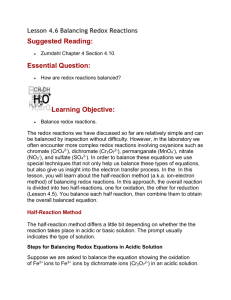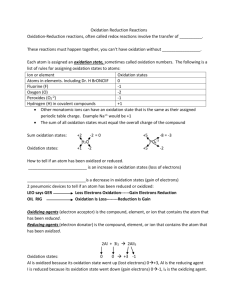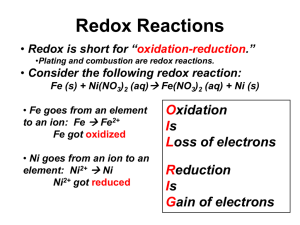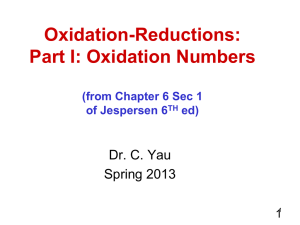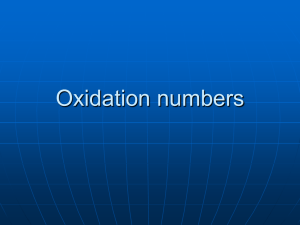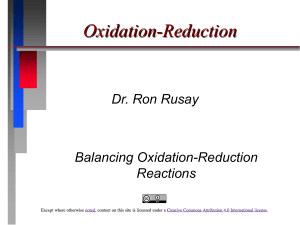9.2 Redox reactions
advertisement
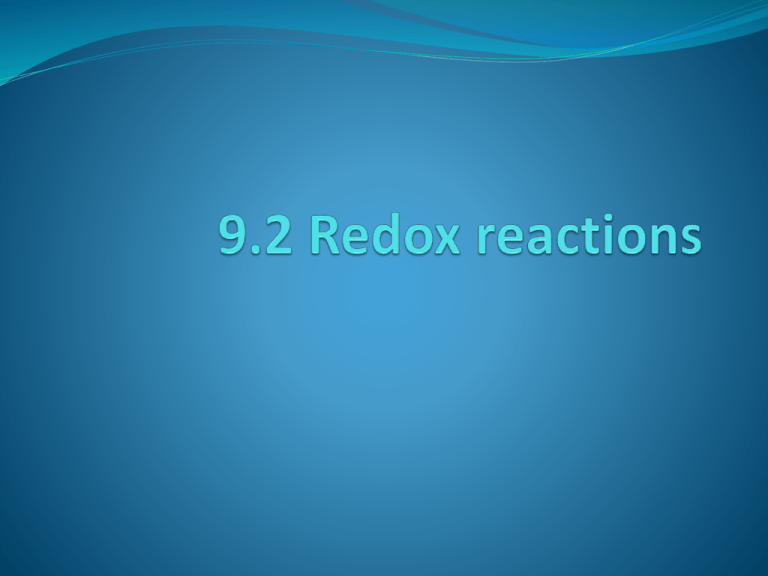
9.2.1: Deduce simple oxidation and reduction half-equations given the species involved in a redox reaction Step 1: Identify the oxidation states of the species on either side of the reaction. Step 2: Identify the oxidation half reaction by identifying which reactant undergoes oxidation. Identify the reduction half reaction by identifying which reactant undergoes reduction. Step 3: Deduce the number of electrons transferred and produce half-equations. Example: In the reaction between chlorine and potassium iodide solution the products are iodine and potassium chloride solution. Cl2 + KI I2 + KCl This is the unbalanced skeleton equation. Redox half-reactions can be used to balance complex reaction equations Example: In the reaction between chlorine and potassium iodide solution the products are iodine and potassium chloride solution. Step 1: Identify the oxidation states of the species on either side of the reaction. 0 Cl 2 + +1 -1 K I 0 I 2 + +1 -1 K Cl Example: In the reaction between chlorine and potassium iodide solution the products are iodine and potassium chloride solution. Step 2: Identify the OXidation half reaction by identifying which reactant undergoes oxidation. Identify the REDuction half reaction by identifying which reactant undergoes oxidation. RED 0 Cl 2 + +1 -1 K I OX Cl2 is reduced to Cl I-1 is oxidised to I2 K+ does not change = spectator 0 I 2 + +1 -1 K Cl Example: In the reaction between chlorine and potassium iodide solution the products are iodine and potassium chloride solution. Step 3: Deduce the number of electrons transferred and produce half-equations. OXIDATION HALF-REACTION (Oxidation is Loss of Electrons) Electrons are removed from the reactant (appear as product) Balance number of atoms 2I-1 I02+ 2e- CHARGE IS CONSERVED REDUCTION HALF-REACTION (Reduction is Gain of Electrons) Electrons are added to a reactant. Cl02+ 2e-2Cl-1 9.2.2: Deduce redox equations using half-equations. This means balance chemical equations using electrons in half-reactions H+ and H2O should be used where necessary to balance half -equations in acid solution. The balancing of equations for reactions in alkaline solution will not be assessed. Balancing Redox in Acid Add these steps to balance OXYGEN and HYDROGEN atoms in redox half-reactions Step 1: Balance OXYGEN by adding WATER (H2O) Step 2: Balance the HYDROGEN by adding H+ ions Oxidation of Ethanol using Acidified Dichromate CH3CH2OH + Cr2O72- CH3COOH + Cr3+ + Cr2O72- C2H4O2 + Cr3+ Assign oxidation numbers (H+ and O2- stay constant here) (C2+)2H6O + (Cr6+)2O72- (C0)2H4O2 + Cr3+ Rewritten: C2H6O Carbon in ethanol gets oxidised from 2+ to 0 Chromium in dichromate gets reduced from 6+ to 3+ Oxidation Half-Reaction in Acid OXIDATION HALF-REACTION (2e- per C = 4e-) C2H6O C2H4O2 + 4e Add H2O to balance oxygens C2H6O + H2O C2H4O2 + 4e Add H+ to balance hydrogens C2H6O + H2O C2H4O2 + 4e- + 4H+ net charge on each side is balanced (0) + (0) = (0) + (-4) + (+4) If charge is not balanced, then it is wrong. Reduction Half-Reactions in Acid REDUCTION HALF-REACTION (3e- per Cr = 6e-) Cr2O72- + 6e- 2Cr3+ Add H2O to balance oxygens Cr2O72- + 6e- 2Cr3+ + 7H2O Add H+ to balance hydrogens Cr2O72- + 14H+ + 6e- 2Cr3+ + 7H2O net charge on each side is balanced (-2) + (+14) + (-6) = (+6)+ (0) If charge is not balanced, then it is wrong. Combine Half-Reactions OXIDATION: C2H6O + H2O C2H4O2 + 4e- + 4H+ REDUCTION: Cr2O72- + 14H+ + 6e- 2Cr3+ + 7H2O Multiply each to balance electrons transferred [C2H6O + H2O C2H4O2 + 4e- + 4H+] x 3 [Cr2O72- + 14H+ + 6e- 2Cr3+ + 7H2O] x 2 3C2H6O + 3H2O 3C2H4O2 + 12e- + 12H+ 2Cr2O72- + 28H+ + 12e- 4Cr3+ + 14H2O _______________________________________________________ 3C2H6O + 3H2O + 2Cr2O72- + 28H+ 3C2H4O2 + 12H+ + 4Cr3+ + 14H2O 3C2H6O + 2Cr2O72- + 16H+ 3C2H4O2 + 4Cr3+ + 11H2O Don’t forget to check net charge
